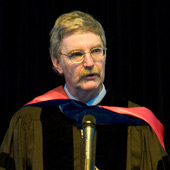
Patrick McDougal
Vollum Award Citation
for Dr. B. Kenneth Koe
Presented by Patrick McDougal, Professor of Chemistry
The Howard Vollum Award for Science and Technology was created and first presented by Reed College in 1975. This award recognizes and celebrates the exceptional achievement of one or more members of the scientific and technical community of the Northwest. The name of the award is a tribute to the late Howard Vollum, one of the nation’s great innovators and technologists, Reed physics alumnus, long-time trustee, and lifelong friend of Reed College.
Each year the president and the Board of Trustees, acting on the recommendation of the Division of Mathematics and Natural Sciences, select a recipient who demonstrates the perseverance, fresh approach to problems and solutions, and imagination that characterized Howard Vollum’s career.
On behalf of the college, I am pleased to cite Dr. Kenneth Koe, Reed class of 1945, as this year’s Vollum Award winner.
As outlined in the short biography in your program Ken spent his professional career as a research scientist at Pfizer where after 40 years he retired in 1995. While Ken is best known for his critical role in the development of Zoloft, the most prescribed antidepressant drug in the United States, I believe the body of Ken’s scientific work reveals a deep-thinking and broadly trained scientist who saw the practical development of a blockbuster drug such as Zoloft as simply the well-deserved fruit of basic research.
After graduating from high school here in Portland Ken received a scholarship that, despite his parents’ modest finances, allowed him to attend Reed College. Ken majored in chemistry. His senior thesis entitled, “An apparatus for the porous disc method of determining osmotic pressure”, was advised by long-time Reed professor Fred Ayres. In Ken’s own words he never had a ‘crashing moment’ when he knew he wanted to be a scientist, he just thought it might be a nice thing to do. Well do it, he did. Soon after completing a Ph.D. and a postdoc at Cal Tech, he joined Pfizer, first at their Brooklyn facility and then at their headquarters in Groton, CT. He was attracted to the pharmaceutical industry because it offered a research environment akin to a university environment. The 100 or so papers he published over his career are testimony to his having taken full advantage of that research environment. After a few years in Pfizer’s antibiotic discovery group he moved into drug metabolism and psychotherapeutic drug discovery. At this point Ken retooled himself as a biochemist and studied the effect of ring halogenated aromatic compounds on psychoactive compounds such as serotonin and amphetamine. One of these compounds p-chlorophenylalanine or PCPA has become a standard research and clinical tool for inhibiting serotonin biosynthesis. The results of Ken’s work was published in a series of papers and two of these seminal papers have been cited so often by other scientists that they have joined an elite subset of scientific articles known as Citation Classics.
In due course Ken’s studies led him to believe that a previously abandoned drug candidate could be modified to become an effective antidepressant. Once modified, he hypothesized the compound should inhibit the reuptake of the important neurotransmitter serotonin thereby boosting its concentration in the brain, a key element in the design of new antidepressants. Ken communicated his ideas to Pfizer’s director of chemistry, Chuck Harbert. In an interview with the AP Ken is quoted as saying, “Usually, directors just ignore your memos, but Chuck followed up on it and assigned a scientist to it.” The scientist was the synthetic chemist, Willard Welsh. Sure enough the introduction of two chlorine atoms into a particular stereoisomer of the previously abandoned molecule produced a compound that boosted the levels of serotonin. To an outsider this might seem to have been a lucky guess but as Ken has said, “Making pharmaceutical drugs takes so much preparation. That light bulb going on takes time to cultivate”. It this case it took 13 years of further development before the compound reached the US market as Zoloft in 1991. It was a wise decision for Pfizer to support Ken’s idea as almost 30 million prescriptions were written for Zoloft in 2007. In March of 2006 Ken and his Pfizer co-workers, accepted a national award from the American Chemical Society for “team innovation” in the discovery of Zoloft.
You read that today’s college students can expect to change jobs and professions numerous times during their career. In this context it might seemed staid that Ken spent his whole career as a research scientist in a single company. But while Ken entered Pfizer as an organic chemist, over his career he acquired the necessary skills in biochemistry, pharmacology and neuroscience to pursue multiple research paths. Perhaps this is best illustrated in a book chapter he co-authored entitled, “Contributions of industrial research to basic neuropsychopharmacology” Neuropsychopharmacolgy? Ken, what happened to the chemist? In discussing Ken’s career, the vice president of discovery at Pfizer says of him, “Ken was always someone who put the quality of the science above all else. He set a high example for all the people who were around him.”
On behalf of the Division of Mathematics and Natural Sciences, I am delighted to congratulate Dr. Kenneth Koe as recipient of the 2008 Vollum Award for Distinguished Accomplishment in Science and Technology.